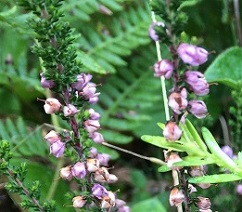
|
|
Practical ecological knowledge for the temperate reader. |
Family: Ericaceae - Crowberry [E-flora]
 |
"Calluna vulgaris is an evergreen Shrub growing to 0.6 m (2ft) by 0.5 m (1ft 8in).
It is hardy to zone (UK) 4. It is in leaf 12-Jan It is in flower from Jul to October, and the seeds ripen from Oct to November. The flowers are hermaphrodite (have both male and female organs) and are pollinated by Bees, flies, lepidoptera, wind.It is noted for attracting wildlife.
Suitable for: light (sandy) and medium (loamy) soils and can grow in nutritionally poor soil. Suitable pH: acid soils and can grow in very acid soils.
It can grow in semi-shade (light woodland) or no shade. It prefers dry or moist soil. The plant can tolerate maritime exposure." [PFAF]
"General: Diffuse shrub to 60 cm tall; stems twisted, bent, reclining or ascending, branched." [IFBC-Eflora]
Status: Exotic [E-flora]
"Habitat / Range
Commonly cultivated, escape in some boggy areas and waste places in the lowland zone; rare in SW BC; introduced from Europe." [IFBC-E-flora] "Acid soils in open woodlands, moors and marshy ground[7]. Often the dominant plant on well-drained acid moors and heaths[17]." "Much of Europe, including Britain, to N. W. Morocco. Less abundant in the east of its range." [PFAF]
Edible Uses
Other Uses
Medicinal Uses
"The medicinal parts are the complete herb with leaves, the flowers, and the growing shoots of the plant that are collected and dried when the plant is in bloom, as well as the fresh aerial parts collected at the same time." [PDR] "Heather is said to be diuretic, antimicrobial, cholagogic and antirheumatic. It is also used as an agent for wound healing. However, these effects have not yet been documented." [PDR]
Select Indications (Heather) — Cancer (f; JLH); Cholecystosis (f; KOM; PH2); Colic (f; KOM; PH2); Enterosis (f; KOM; PH2);Gastrosis (f; KOM; PH2); Gout (f; HHB; KOM); Hepatosis (f; KOM; PH2); Insomnia (f; HHB; PH2); Nephrosis (f; DEM; PH2); Nervousness (f; HHB; PH2); Rheumatism (f; HHB; PH2); Sore (f; HHB; JLH); Water Retention (1; HHB; PH2); [HMH Duke]
Pharmacology
"Activities (Heather) — Antiinflammatory (1; EFS); Antilithic (f; KOM); Antiseptic (f; EFS; PH2); Astringent (1; EFS; HHB); Cholagogue (f; PH2); Depurative (f; EFS); Diaphoretic (f; KOM); Digestive (f; KOM); Diuretic (1; HHB; PH2); Narcotic (f; EFS); Sedative (f; HHB); Urinary Antiseptic (1; EFS; FNF); Vulnerary (f; PH2)." [HMH Duke]
Phytochemicals
"Flavonoids: including kempferol, quercetin, myricetin, taxifolin, and the glycosides of each, as well as callunin" [PDR]
"Catechin tannins (3-7%): (+)-catechin, (-)-epicatechin" [PDR]
"Oligomeric proanthocyanidins" [PDR]
"Caffeic acid derivatives: including chlorogenic acid" [PDR]
"Phenols: orcin, orcinol" [PDR]
"Triterpenes: including ursolic acid (2.5%)" [PDR]
"Steroids: beta-sitosterol" [PDR]
"Hydroquinone glycosides: including arbutin" [PDR]
Cultivation & Propagation
"Requires a light acid soil and a sunny position[138, 182]. Prefers a sunny position but tolerates light shade[186]. Only succeeds if the pH is below 6.5[186]. Prefers a poor peaty soil[11]. Plants are tolerant of fairly dry soils but they dislike prolonged drought[186]. They tolerate wet conditions in the winter[238]. Plants regenerate well from the base after a fire if the heat was not too great, if the fire was slow and intense then new seedlings will quickly become established[186]. Commonly grown in the ornamental garden, there are many named varieties[200, 238]. The flowers are rich in nectar and are very attractive to bees, butterflies and moths[7, 11, 30]. This plant is also an important food source for the caterpillars of many lepidoptera[30]." [PFAF]
"Seed - sow as soon as it is ripe or in February in a shaded part of the greenhouse[78, 113]. Surface sow or only just cover the seed[113, 138]. Cold stratification for 4 - 20 weeks aids germination[138]. The seed usually germinates in 1 - 2 months at 20oc. When large enough to handle, prick the seedlings out into individual pots and grow them on in the greenhouse for at least their first winter, planting them out into their permanent positions in late spring or early summer, after the last expected frosts. Cuttings of half-ripe wood 4 - 5cm with a heel, July/August in a frame. Good percentage[78]. Cuttings of mature wood of the current season's growth, 5 - 7cm with a heel, October/November in a frame. Good percentage[78]. Layering in autumn[78]. Division in spring. Dig up the plant 12 months prior to division and replant it 15 - 30cm deeper in the soil in order to encourage rooting along the stems. When ready to take the divisions, it is just a matter of digging up the plant and cutting off sections of stem with roots on them. These are best potted up and kept in a cold frame or greenhouse until they are well rooted before planting them out in the summer or following spring." [PFAF]
Groundcover: "A useful ground cover plant for covering dry banks[188, 197]. The cultivar 'White Lawn' has been recommended[188]. All except the very dwarf cultivars will need trimming each spring in order to keep them compact[208]." [PFAF]
Synonyms
Erica vulgaris [PFAF]
"Calluna vulgaris, common heather, ling, or simply heather,[1] is the sole species in the genus Calluna in the flowering plant family Ericaceae." [Wiki]
References